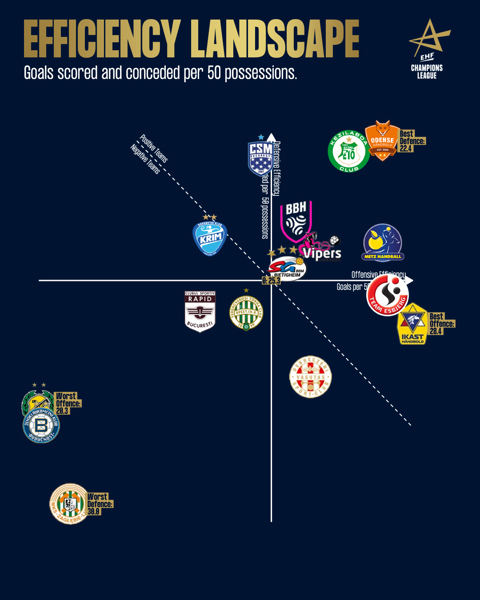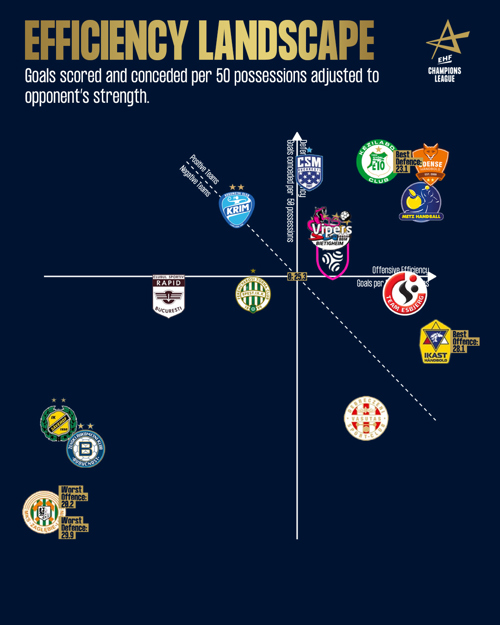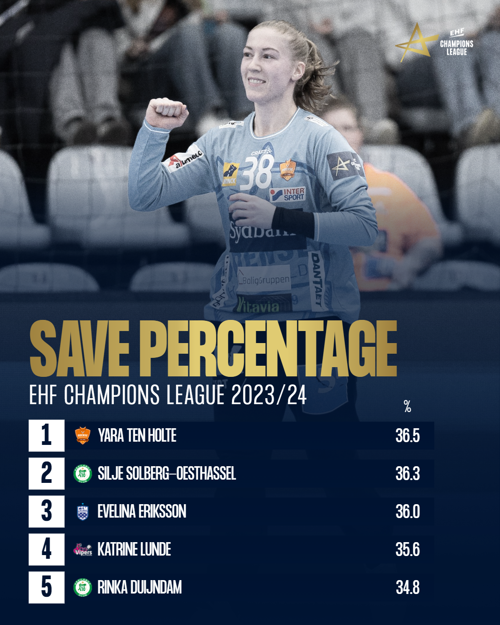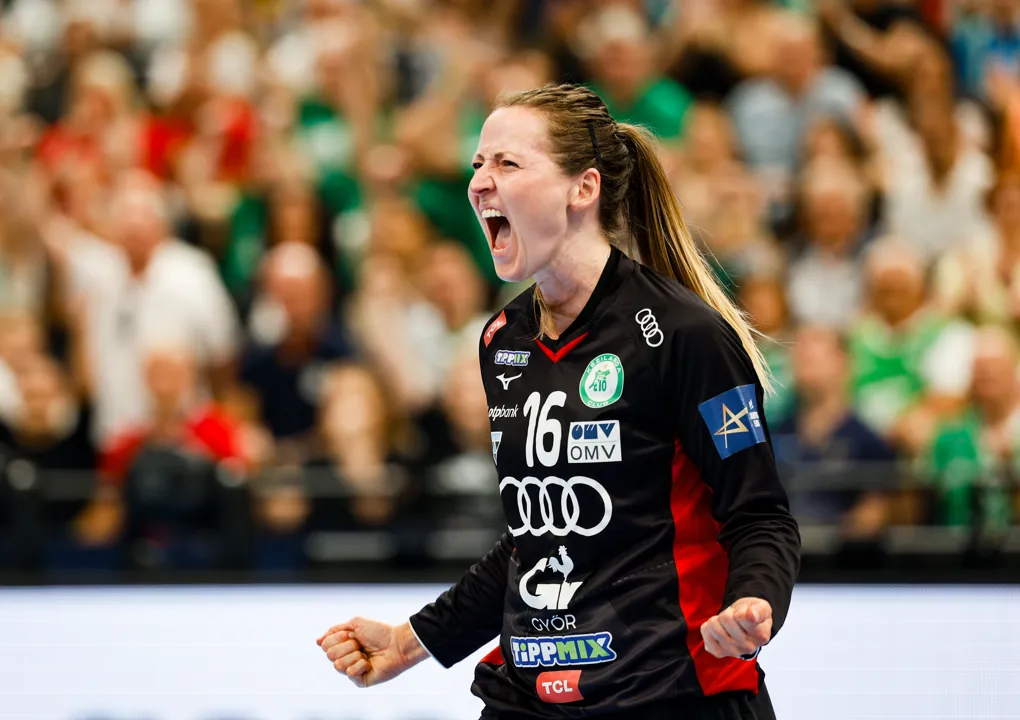Even though Bietigheim regularly pulled off surprises in the knockout matches, including the semi-final on Saturday, it was hardly surprising and fully deserved that Györi Audi ETO KC prevailed in the final. They were the better team over the entire season.
During the season, Györ had the second-best defence conceding only 22.6 goals per 50 possessions, just behind Odense Håndbold’s 22.4. In offence, they ranked fifth with 27.0 goals per 50 possessions. Therefore, their net difference between offence and defence is 4.4, the second best. Bietigheim’s 25.7 goals per 50 possessions and 25.0 goals conceded per 50 possessions means that they rank nine in attack and eighth in defence. Their net goal difference is 0.7, ninth best.

Using these statistics that are adjusted for possessions played is significantly more meaningful than just the raw number of goals (conceded) because it makes the teams actually comparable since the raw number of goals is not only influenced by efficiency, but also by the number of possessions (whether a team and their opponents play rather fast or slow). Since a game has roughly 50 possessions on average (56.8 this season), the values here are calculated on 50 possessions so that they roughly reflect those of a game.
The problem with these and all the other stats is that teams such as Györ and Bietigheim that made it far in the competition face remarkably harder opponents than the teams that are eliminated early. To take this into account, the aforementioned metrics can be adjusted for opponent strength as well.
The adjustment is done by calculating how many goals (conceded) per 50 possessions would be expected for each game and team by the number of goals the opponents scored and conceded per 50 possessions in their other games. The differences between the actual goals scored and conceded can then be added to the goals scored or conceded per 50 possessions to have an adjusted rating.
Applying this, Bietigheim’s numbers improved significantly since they faced clearly better-than-average opponents in the knockout stage. Their offence improves to 26.0 goals per 50 possessions and their defence to 24.4. Overall, that’s an improvement of 0.8, more than any other team, even though they improve just one rank in each category. In the net goal difference per 50 possessions, however, they improve from rank nine to seven with 1.5 now.

Györ rank fifth in adjusted offence with 27.0 goals per 50 possessions and first in defence, conceding just 23.1 goals per 50 possessions. So we can say that they actually do have the best defence. Their net between these two ratings is 4.4, still the second-highest behind Odense, who were eliminated by Bietigheim in the quarterfinal.
Györ excelled defensively in the final as well
Györ also proved in the final that they have the best defence. Bietigheim was only able to score 20.3 goals per 50 possessions in the final, their worst offensive performance of the season and Györ’s fourth-best defensive display.
It was Bietigheim's shooting percentage in particular that was the problem for them. They scored just on 51 per cent of their attempts, their worst of the season, while Györ had the second-best performance of the season in this regard. From the field, exactly half of Bietigheim’s attempts were successful, their second-worst of the season, while Györ had their third-best performance in attack.
Györ themselves scored 25.4 goals per 50 possessions, which was below average for them this season. But it was enough, thanks to their impressively strong defence. Ana Gros summarised after the game: “We said before the game that we have to have an amazing defence because they are such physical players. And I think it worked so well. We were really aggressive with them from the beginning. We didn’t let them come through so easily.” In addition, her coach Per Johansson emphasized that they “put enormous hours on developing defence.”
Besides that, especially noticeable were the differences in the wingers between the two teams. From the field, Györ’s Viktória Gyori-Lukács, Csenge Fodor and Nadine Szollosi-Schatzl scored on 10 of their 14 attempts (71.4 per cent). In contrast, Bietigheim’s Veronika Mala, Dorottya Faluvégi and Antje Döll were just able to convert 6 of their 16 shots (37.5 per cent). The Hungarians simply managed to get their wingers into good positions with wide angles again and again, while the southern Germans had to finish from small angles several times.
Another big difference was related to the goalkeepers. Gabriela Moreschi, who had a huge part in Bietigheim’s run to the final, had less than 30 per cent save percentage, for the second time in the knockout stage. She was just able to save 20.7 per cent of the attempts on her goal, her second-worst of the season. Her backup, Sarah Nørklit, saved 36.4 per cent, but played considerably less, as she has done all season, as Moreschi was usually the outstanding player.
On the other side, Silje Solberg-Oesthassel saved with an outstanding 42.1 per cent save efficiency, her second-best this season, and was the deciding player. Even over the whole season, only Yara Ten Holte had a better save percentage (36.5 per cent) than the Norwegian (36.3 per cent). However, she only played 10 games this season.

In addition, penalties, the one problem Györ had coming into the EHF FINAL4, were no problem for them at all as they had the best percentage and the most different shooters amongst the four teams. Ana Gros just missed one out of two against Team Esbjerg and made five out of seven in the final. In addition, Veronica Kristiansen scored on her one attempt in the semi-final.
So, overall, Györ's victory was clearly deserved. They capitalised on their biggest weakness and played brilliantly in defence.
More from data analyst Julian Rux can be found at Handballytics.de. There you can read his latest articles, in which he analyses all kinds of handball topics from new, data-based perspectives. You can also find him on Instagram, Facebook, X/Twitter, Threads and WhatsApp Channels.
Main photo © Anze Malovrh/Kolektiff









